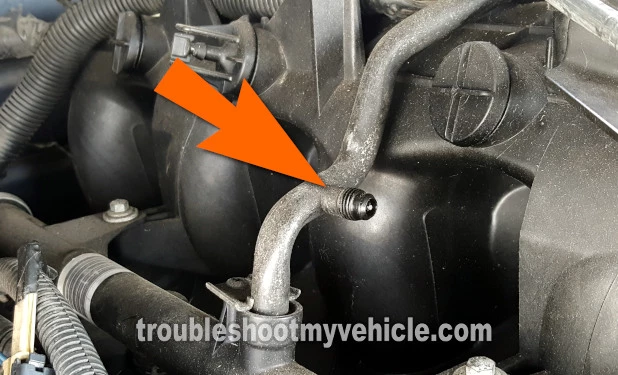
Testing the fuel pump on your 2003-2007 V8 equipped Chevrolet Express (GMC Savana) van can easily and accurately be done with a fuel pressure test gauge.
In this tutorial, I'll explain how it's done so that you can find out if the fuel pump is good or bad. I'm also gonna explain how to use starting fluid to see if the engine is not starting due to a lack of fuel.
Contents of this tutorial:
- Common Symptoms Of A Bad Fuel Pump.
- Where To Buy A Fuel Pressure Test Gauge.
- Safety Precautions To Take When Testing The Fuel Pump Pressure.
- TEST 1: Testing The Fuel Pressure With A Fuel Pressure Test Gauge.
- TEST 2: Using Starting Fluid To Diagnose A No-Start Condition.
- More Chevy Express/GMC Savana Articles And Tutorials.
ES ![]() You can find this tutorial in Spanish here: Probando La Bomba De Combustible (2003-2007 V8 Chevy Express, GMC Savana) (at: autotecnico-online.com).
You can find this tutorial in Spanish here: Probando La Bomba De Combustible (2003-2007 V8 Chevy Express, GMC Savana) (at: autotecnico-online.com).
APPLIES TO: This tutorial applies to the following vehicles:
- Chevrolet Express (1500) 4.8L, 5.3L: 2003, 2004, 2005, 2006, 2007.
- Chevrolet Express (2500) 4.8L, 5.3L, 6.0L: 2003, 2004, 2005, 2006, 2007.
- Chevrolet Express (3500) 4.8L, 6.0L: 2003, 2004, 2005, 2006, 2007.
- GMC Savana (1500) 4.8L, 5.3L: 2003, 2004, 2005, 2006, 2007.
- GMC Savana (2500) 4.8L, 5.3L, 6.0L: 2003, 2004, 2005, 2006, 2007.
- GMC Savana (3500) 4.8L, 6.0L: 2003, 2004, 2005, 2006, 2007.
RELATED WIRING DIAGRAM:
NOTE: You can find the fuel pump test procedure for the 2008-2013 V8 Chevy Express And GMC Savana here:
Common Symptoms Of A Bad Fuel Pump
A fuel pump will generally fail in one of two ways:
- Engine No-Start: The fuel pump stops working completely (producing no fuel pressure) and causes an engine no-start problem.
- Engine Starts But Run Bad: The fuel pump is failing but still produces enough fuel pressure to start the engine. Unfortunately, it's not enough fuel pressure to pump the volume of fuel the engine needs to run under load (like driving).
These are the symptoms that you'll see when the fuel pump has failed or is starting to fail:
- Engine No Start: The engine cranks but does not start.
- Stalling After Start: The engine starts but stalls after a few seconds.
- Stalling On Acceleration: The engine starts but as soon as you step on the accelerator pedal, the engine stalls.
- No Power Under Load: Lack of power while driving the vehicle.
- Backfiring: Explosions (loud popping sounds) can be heard coming from the intake manifold when you step on the accelerator while the engine is under load.
- Check Engine Light Illuminated: The check engine light is on, and lean air-fuel mixture trouble codes are stored in the fuel injection computer's memory.
I want to point out before moving on the next heading, that other components (when they fail) can also cause similar problems/symptoms and mimic a failing fuel pump. That's why it's essential to check the fuel pump's pressure output with a fuel pressure gauge before deciding to replace it. This is what this tutorial will help you do.
Where To Buy A Fuel Pressure Test Gauge
You can buy a fuel pressure test gauge just about anywhere and is one of the most important tools any serious DIY'er should have in his/her tool box.
All of the following fuel pressure test gauge kits will help test your Chevrolet Silverado or GMC Sierra's fuel pump:
Disclosure: As an Amazon Associate, I earn from qualifying purchases. If my tutorials help you, using these links is an easy way to support the site at no extra cost to you. Thank you!
Safety Precautions To Take When Testing The Fuel Pump Pressure
Before you begin, remember to play it safe to avoid any accidents or surprises. Here are a couple of important precautions to take:
- Work with a Cold Engine: Ensure the engine has cooled down completely before you start. A hot engine not only poses a burn risk but also increases the flammability of gasoline or starting fluid.
- Avoid Flames and Sparks: Gasoline and starting fluid are extremely flammable. Work in a well-ventilated area and ensure there are no open flames, sparks, or anything that could ignite the fuel. This includes cigarettes, lighters, and even small sparks from electrical equipment.
- Wear Protective Gear: Use safety glasses to protect your eyes and gloves to shield your hands from gasoline or starting fluid.
- Have a Fire Extinguisher Nearby: Always have a suitable fire extinguisher within reach in case of an emergency.
- Follow Manufacturer Instructions: Ensure you're using the fuel pressure gauge correctly. Read and follow the manufacturer's instructions carefully.
By following these safety measures, you can minimize the risk of accidents and perform the pressure check effectively and safely.
TEST 1: Testing The Fuel Pressure With A Fuel Pressure Test Gauge

To test the fuel pump, we're going to connect a fuel pressure test gauge to the Schrader valve located on the fuel injector rail.
The illustration above and the photo at the beginning of the tutorial show the location of the Schrader valve and what it looks like on your Chevrolet Express (GMC Savana).
NOTE: You'll need a fuel pressure tester that can connect to the Schrader valve. If you don't have one, take a loot at my recommendations here: Where To Buy A Fuel Pressure Test Gauge.
FUEL PRESSURE SPECIFICATION: The fuel pressure specification for the 2003-2007 4.8L, 5.3L, 6.0L Chevrolet Express (GMC Savana) is 55 to 62 PSI. Flex fuel engines: 48-54 PSI.
These are the test steps:
- 1
Locate the Schrader valve on the fuel injector rail crossover line (see photo at the beginning of the tutorial).
- 2
Remove the dust cap from the Schrader valve and place a shop towel under the general area of the Schrader valve.
NOTE: The shop towel's job is to absorb and fuel that may leak when performing step 3. - 3
Connect your fuel pressure tester to the Schrader valve.
- 4
Have your helper crank the engine while you observe the needle on the fuel pressure tester gauge.
- 5
The fuel pressure tester should give you a reading between 55 to 62 PSI.
Let's examine your test results:
CASE 1: The fuel pressure is within the indicated specification. This is the correct test result.
This test result confirms that the fuel pump in your Express (Savana) van is OK (functioning correctly).
CASE 2: You got 0 psi fuel pressure. This test result lets you know that the fuel pump is defective and is causing the engine to not start.
Before you replace a fuel pump make sure that the fuel pump relay and fuel pump fuse are supplying power to the fuel pump when the engine is being cranked.
If battery power is available to the fuel pump, when cranking the engine, then you can confidently conclude that the fuel pump is defective and that it needs to be replaced.
CASE 3: The fuel pressure was below the indicated fuel pressure specification. This test result lets you know that even though the fuel pump is supplying some fuel it's not supplying enough to have the engine run optimally.
This is an indication that the fuel pump is failing and needs to be replaced.
TEST 2: Using Starting Fluid To Diagnose A No-Start Condition

The starting fluid test is a test that I've used quite a bit over the years to find out if the engine's no-start problem is due to a lack of fuel.
The starting fluid test involves spraying starting fluid into the throttle body and then having a helper crank the engine.
If a lack of fuel is causing the engine's no-start problem, then the engine will start for a few seconds and then die (as the starting fluid is consumed).
If the engine does not start, you can conclude that the no-start problem is not due to a lack of fuel.
One essential thing to keep in mind is that the starting fluid test is not a very accurate way to diagnose a bad fuel pump (compared to a fuel pump pressure test).
Even so, the starting fluid test does help in pinpointing the engine's no-start problem to lack of fuel (if that's the cause).
IMPORTANT: To get the most accurate test result from your starting fluid test, it's important that you first check that all 8 cylinders are getting spark. So if you haven't already checked for spark yet, you should do so before doing the starting fluid test.
These are the test steps:
- 1
Remove the intake air duct from the throttle body. You don't have to completely remove it, since you'll have to reconnect it in step 2.
- 2
Spray starting fluid down the bore of the throttle body.
.
After spraying a good squirt of starting fluid, quickly reconnect the air duct to the throttle body (you don't have to tighten the hose clamp) - 3
Have your helper crank the engine once the intake air duct is back on the throttle body.
- 4
You'll get one of two results with this test:
1.) The engine will start momentarily and after a few seconds will die.
2.) The engine will only crank but not start at all.
OK, let's find out what your results mean:
CASE 1: The engine did not start, not even a few seconds. This test result tells you that a lack of fuel from the fuel pump IS NOT causing the engine's no-start problem.
I want to point out that this conclusion is true only if all spark plug wires are sparking.
CASE 2: The engine started but died after a few seconds. This test result tells you that the engine's no-start problem is caused by a lack of fuel.
More Chevy Express/GMC Savana Articles And Tutorials
You can find a complete list of articles and diagnostic tutorials for the V8 Chevy Express and GMC Savana here:
Here's a sample of the tutorials you'll find in the index:
- How To Test For The Fuel Pump (2008-2013 V8 Chevy Express, GMC Savana).
- How To Test The CKP Sensor (2008-2013 Chevrolet Express, GMC Savana).
- How To Test For A Blown Head Gasket (2003-2013 V8 Chevy Express, GMC Savana).
- How To Diagnose An Engine Cranks But Does Not Start Problem (2003-2007 V8 Chevy Express, GMC Savana).

If this info saved the day, buy me a beer!





